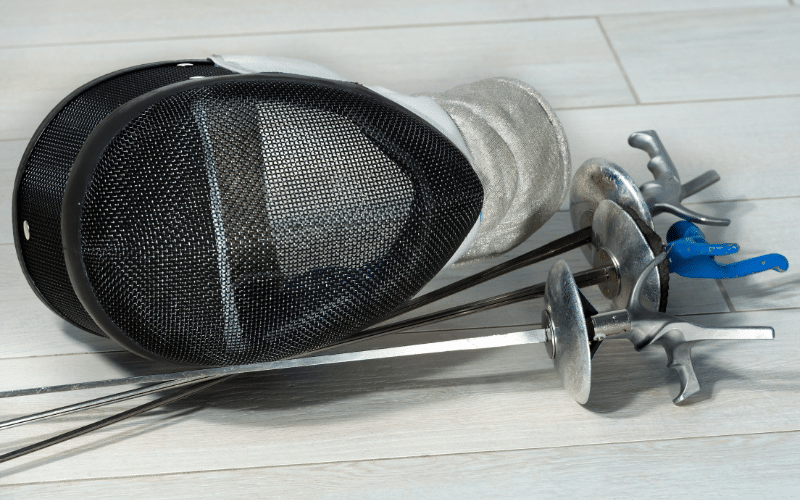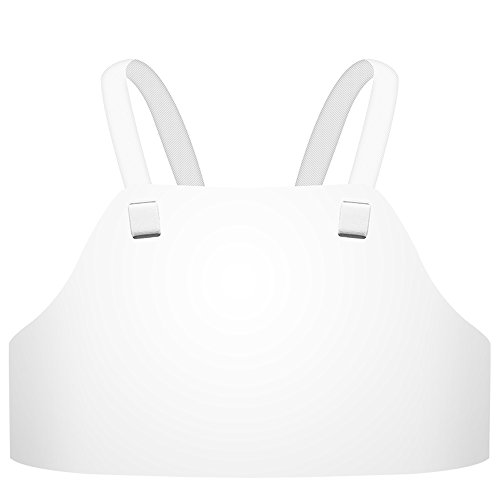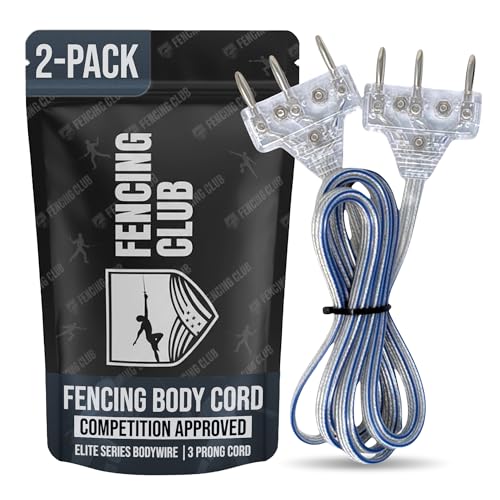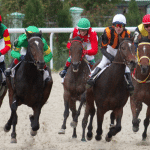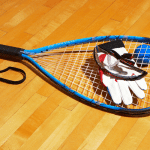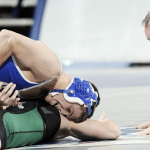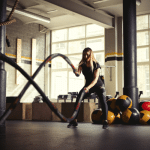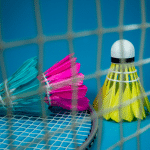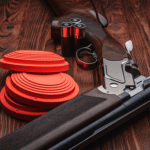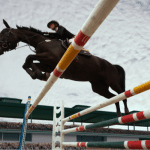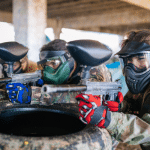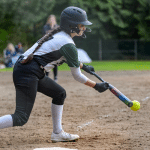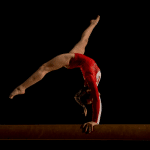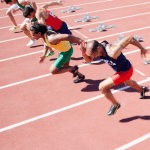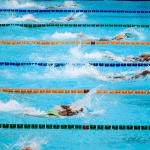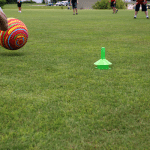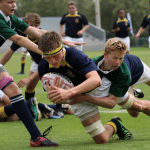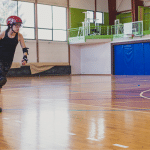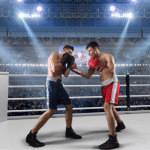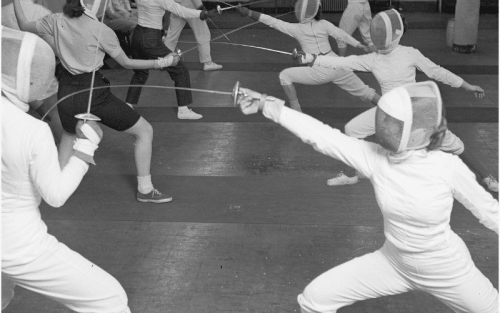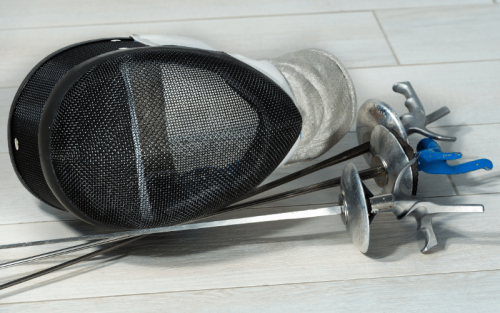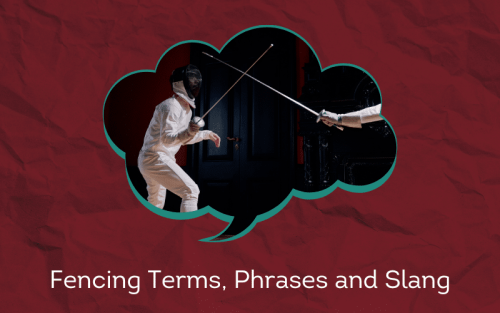Imagine stepping onto the piste, your heart racing, the metallic scent of determination and steel hanging in the air.
Welcome to the world of fencing, where every piece of gear plays a crucial part in your combat saga!
Prepare to gear up for glory with our ultimate fencing equipment checklist. En garde!

For Fencers:
- Foil, Épée, or Sabre (depending on the discipline)
- Mask
- Fencing Jacket
- Plastron (underarm protector)
- Glove (for the weapon hand)
- Breeches
- Chest Protector (required for women)
- Electric Scoring Equipment (body cord, lame if required)
- Fencing Shoes
- Water Bottle
For Coaches and Teams:
- Electric Scoring System
- Training Weapons and Masks
- First Aid Kit
- Video Analysis Equipment
- Team Uniforms
For Facilities:
- Fencing Piste(s)
- Electronic Scoring Machines
- Observation Area for Spectators
- Locker Rooms
- Equipment Repair Station
Equipment for Fencers
#1 Foil, Épée, or Sabre

The choice of foil, épée, or sabre defines the fencing discipline and influences the rules and scoring. Each weapon has unique characteristics that affect technique and strategy, making the appropriate selection vital to the fencer’s performance.
#2 Mask
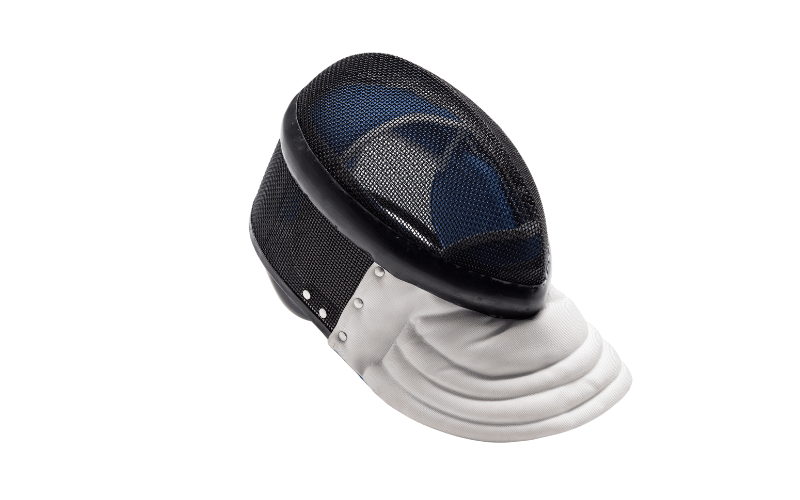
A fencing mask provides critical facial and head protection during bouts. Its sturdy mesh design allows visibility while preventing penetration by the weapon’s tip. Safety and visibility are important, making the mask a non-negotiable piece of fencing equipment.
#3 Fencing Jacket
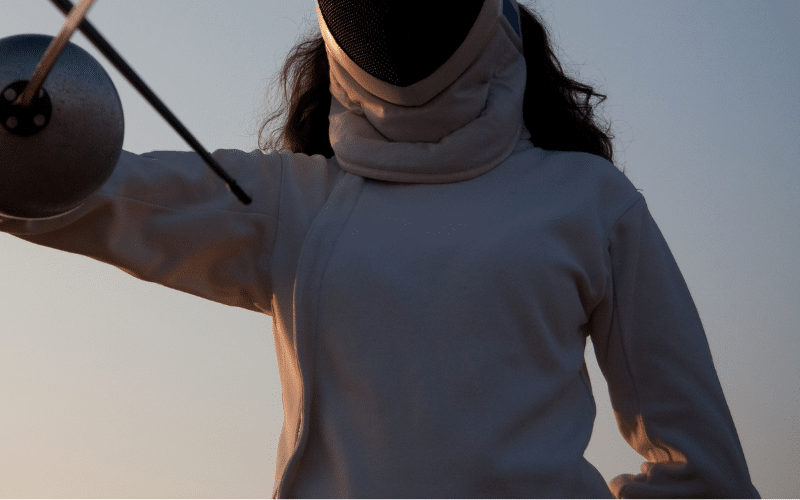
The fencing jacket protects the torso and arms against weapon strikes. It’s made of durable fabric to withstand punctures and designed for mobility. This garment is essential for safety and adhering to regulations during training or competition.
#4 Plastron (underarm protector)
An underarm protector, or plastron, offers an additional layer of safety, especially in the vulnerable underarm area, which is exposed during arm movements. Its use is a standard safety protocol to prevent potential injuries.
#5 Glove (for the weapon hand)
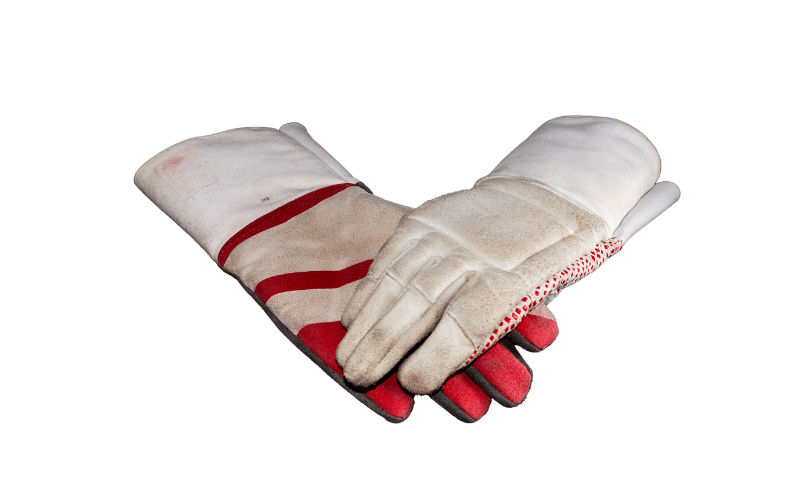
The fencing glove shields the weapon hand from hits and provides a better grip on the weapon. It is designed to be flexible yet protective, balancing dexterity with safety, and is mandatory for fencers.
#6 Breeches
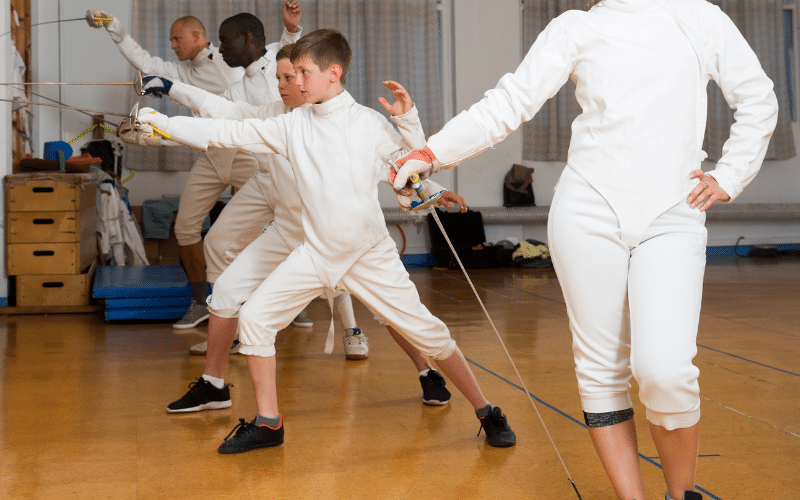
Fencing breeches are knee-length trousers providing protection for the lower body. They are reinforced to prevent penetration from weapon tips and designed for maximum mobility. This specialized attire is an integral part of a fencer’s protective gear.
#7 Chest Protector (required for women)
Chest protectors are mandatory for female fencers, offering crucial protection for the chest area. They reduce the impact of thrusts or hits, increasing safety and allowing fencers to compete with confidence.
#8 Electric Scoring Equipment (body cord, lame if required)
For accurate scoring, fencers use electric scoring equipment. The body cord connects the weapon to the scoring system, while the lame (a conductive garment) is used in foil and sabre to register valid touches. Essential for modern fencing, they ensure fair and precise results.
#9 Fencing Shoes
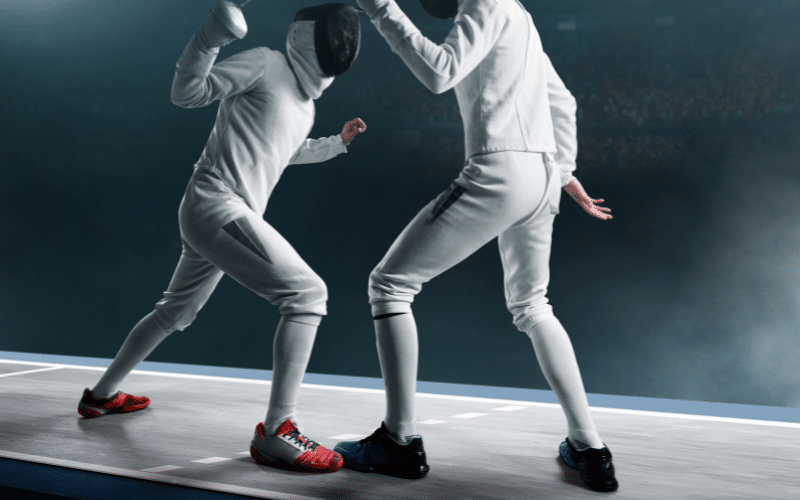
Footwork is fundamental in fencing, making purpose-built fencing shoes essential. They provide grip, support, and flexibility, aiding in quick movements while helping to minimize the risk of foot and ankle injuries.
#10 Water Bottle

Hydration keeps fencers alert and agile. Having a water bottle at hand is crucial, especially during long tournaments or intensive training sessions. It is a simple yet essential item for maintaining good physical condition and focus.
Equipment for Coaches and Teams
#1 Electric Scoring System
The electric scoring system is crucial for accurately recording hits and touches in fencing bouts, providing immediate feedback to fencers and spectators. It ensures fair play and enhances the viewing experience by clearly displaying the scoring in real time.
#2 Training Weapons and Masks
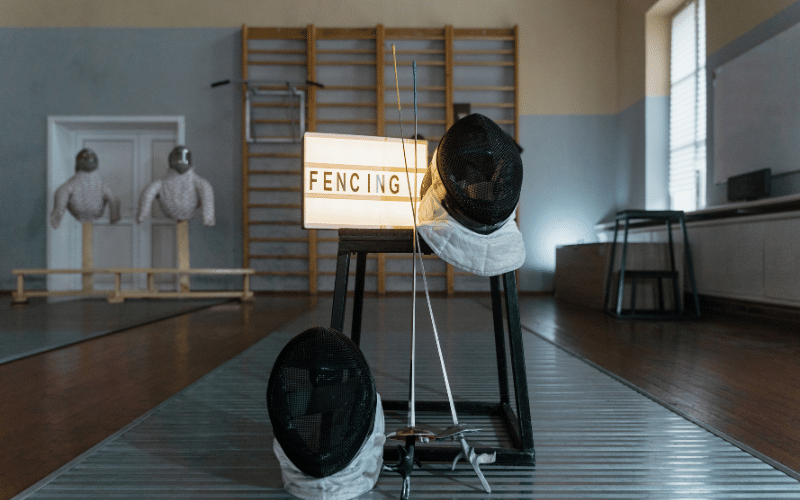
Training weapons and masks are foundational to safely teach and practice fencing techniques. They allow fencers to hone their skills without the risk associated with competitive blades and ensure that both coaches and athletes can focus on skill development with proper protection.
#3 First Aid Kit
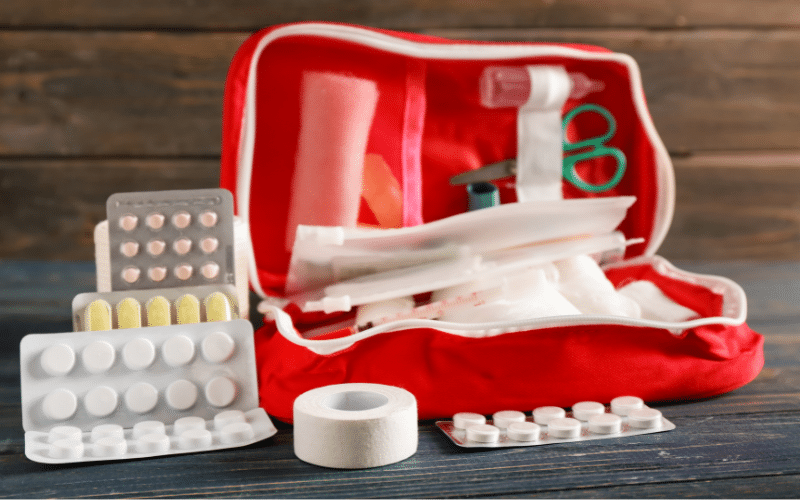
A first aid kit is imperative for any fencing team to manage minor injuries and emergencies. Stocked with essential supplies, it allows for prompt treatment of common fencing-related injuries like bruises, blisters, and cuts, promoting the well-being of all participants.
#4 Video Analysis Equipment
Video analysis equipment is invaluable for improving performance through visual feedback. It helps fencers and coaches analyze technique and bout strategy, enabling detailed review and advanced preparation against competitors, thus elevating the level of training and competition.
#5 Team Uniforms
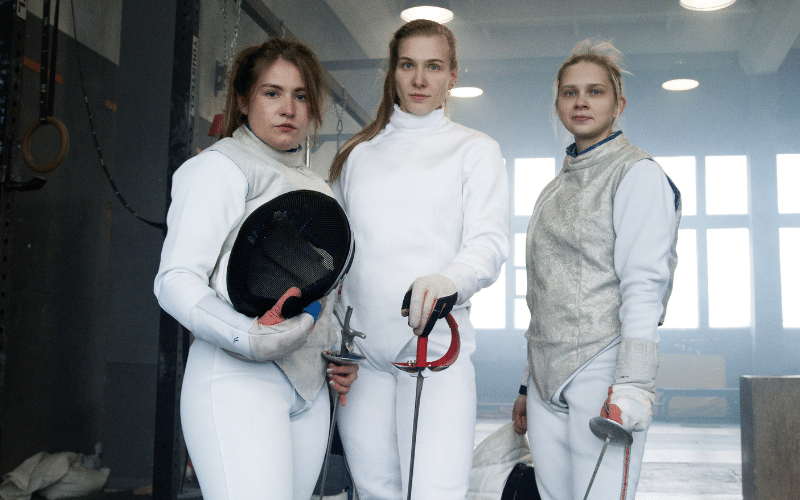
Team uniforms are essential for fostering unity and professionalism among team members. They help identify athletes during competitions, promote team spirit, and contribute to a polished and organized appearance, reflecting dedication and pride in the sport of fencing.
Equipment for Facilities
#1 Fencing Piste(s)
The fencing piste is the designated stage for bouts, a critical component of the sport. Its specific dimensions and non-slip surface facilitate proper footwork and tactics, crucial for the safety and fairness of fencing competition. It’s where all the action happens, emphasizing the duel’s precision and skill.
#2 Electronic Scoring Machines
Electronic scoring machines are vital in recording touches accurately and swiftly in fencing. They provide instant, unbiased results, which are essential for the smooth operation of matches. This technology ensures fair play and enhances the spectator experience by allowing the audience to follow the score in real time.
#3 Observation Area for Spectators
An observation area allows spectators to view fencing matches comfortably and safely. It’s essential for promoting the sport and providing an enjoyable experience for audiences, enabling them to appreciate the skill and finesse of fencers while supporting their favored athletes or teams.
#4 Locker Rooms
Locker rooms offer fencers a private space to prepare before matches and unwind afterward. They are an essential facility for storing personal and valuable equipment securely, allowing competitors to focus on their performance with peace of mind about the safety of their gear.
#5 Equipment Repair Station
An equipment repair station is crucial in a fencing facility to ensure all gear is in top condition for training and competition. Quick fixes and maintenance of weapons, masks, and body cords prevent delays in bouts and help uphold the safety and integrity of the sport.
Understanding the dimensions and space you’ll be competing in can help you choose the right equipment, so consider learning about fencing piste dimensions.

FAQ
What is the equipment you need to play Fencing?
Fencing swords, masks, protective clothing, and a fencing piste are the equipment you need to play Fencing. These are essential for safe practice and competition.
What is the most important equipment in Fencing?
The mask is the most important equipment in Fencing as it protects the face and neck from potential injury during bouts.
What is a recommended list of Fencing equipment for beginners?
Here’s a recommended list of Fencing equipment for beginners: a basic fencing foil (or epee/sabre), a fencing mask, a jacket, a glove, and a chest protector. This gear offers protection and allows practice of fundamental moves.

